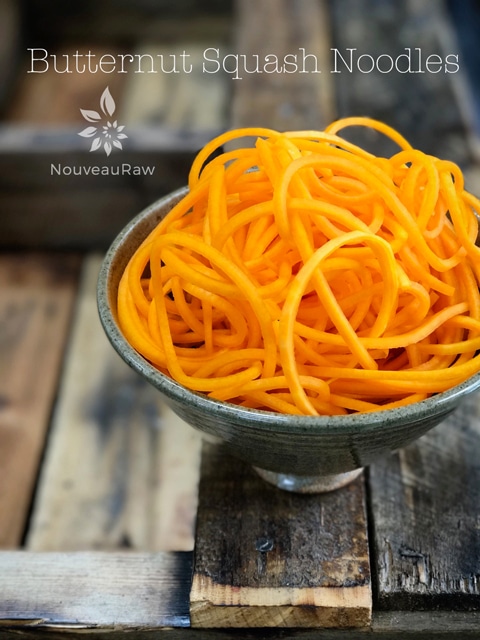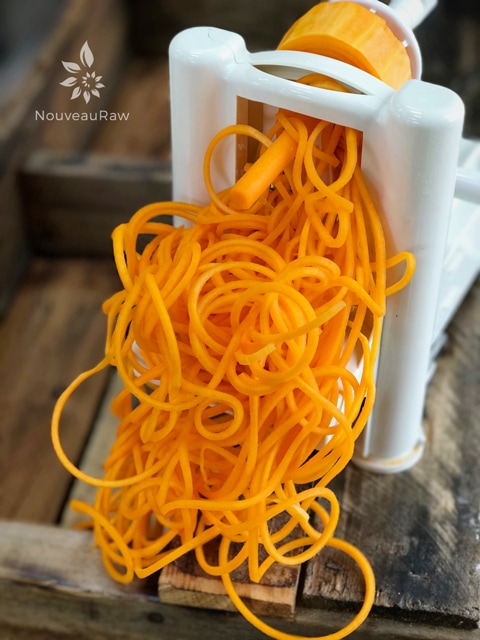Butternut Squash Noodles

 Add to favorites
Add to favorites
Butternut Squash Noodles

~ raw, vegan, gluten-free, nut-free, alkaline ~
The butternut has a pale tangerine hue; this is a noteworthy health perk. The color indicates an abundance of powerhouse nutrients known as carotenoids, shown to protect against heart disease.
These hourglass-shaped gourds hurt when you drop them on your big toe and boast high levels of beta-carotene which our bodies will automatically convert to vitamin A.
Need a good dose of vitamin C? Stop popping those pills… in a one-cup serving, you will get nearly half the recommended daily dose of vitamin C. As if this weren’t enough, butternut squash is known to have anti-inflammatory effects because of its high antioxidant content.
These pale-skinned beauties have a wonderful shelf-life. It is so self-reliant that it doesn’t even need to be refrigerated, just store in a cool dark place for a few weeks.
How to Select Butternut Squash:
To select a good butternut, it all starts with picking it up. First of all, it should be heavy for its size. Next, start rolling it around in your hands looking for bruises or other strange blemishes. We want to avoid those along with any cracks… cracks can collect bacteria.
When selecting a butternut squash for noodle making, look for squashes with a long neck, this is the part that is solid with flesh which makes for great noodles. The bulbous end houses the seeds.
Benefits of Butternut Squash Noodles:
These noodles are fat-free and can be enjoyed raw or added to cooked soups. One of the health benefits that really speaks to me is the fiber content. They contain soluble and insoluble dietary fiber. Just one cup of cubed butternut squash has 3 grams of fiber. Insoluble fiber adds bulk to digested food, which helps it travel through the digestive tract and prevents constipation. Soluble fiber slows the absorption of carbohydrates, which prevents large spikes in blood sugar after you eat. So how can you go wrong by adding this veggie into your diet!
Butternut Squash pairs well with sage and rosemary, either of which can be used fresh or in dried form. The warm “pie spices” such as nutmeg and ginger are a good match for butternut squash, balancing its sweetness. For a savory approach, cumin is a good candidate. Chilies provide a delicious sweet-and-spicy flavor combination. The naturally sweet taste of butternut squash is enhanced when paired with fruit, such as fresh and dried apples, fresh pear, orange juice, and dried cranberries. So as you can see, the possibilities are almost endless. :)
 Ingredients:
Ingredients:
Preparation:
- Be sure to pick the freshest, in season, butternut squash that you can find. This will ensure that you get the best tasting noodles possible.
- The only part that you will be spiraling on the butternut squash is the neck. The flesh here is solid and works best for creating noodles. If the flesh is mushy, it won’t work on the spiralizer.
- With a potato peeler, remove the skin from the neck part of the squash.
- Place the unit on the countertop and press down on the spiralizer to engage the suction cups and secure.
- Insert the blade cartridge you’d like to use, make sure that it clicks into place.
- Cut the butternut into 4-6” length pieces.
- Place the center of the butternut onto the cylinder part of the blade and press the teeth of the handle into the other side of it.
- Take hold of the handle on the bottom (the horizontal one) with one hand and then spin the handle with the teeth to spiralize. Press steadily with forward pressure, using the handle that you’re gripping, for best results.
- Before dressing up the noodles, take scissors when you’re done spiralizing and cut the noodles into manageable sized pieces. Just grab a bunch of noodles and roughly snip. Or enjoy that never-ending noodle!
- You can make noodles in advance, they should keep for 5-7 days in the fridge, without sauce.
To clean the spiralizer:
- Purchase an inexpensive handled brush for cleaning the blade parts and hard to reach parts on the unit. This will save your fingers and prevent nicks from happening on the blades, keeping them nice and sharp.
- Be sure to quickly rinse the unit after creating noodles. The juices from certain root veggies can stain the unit.
- Dry the blades well before putting them away.
Tools used to create noodles:
GEFU Spiralfix Spiral Slicer 13410 $49.95
GEFU Spiralfix Spiral Slicer
- Can be used in the left or right hand.
- 4 different widths of cut for creative recipes: Spiral cut across the entire width of the material, 3 mm, 6 mm, or 12 mm wide adjustable via adjusting wheel
- Folding lid for easy filling
- Detachable non-slip holding container for safe standing
- Material: stainless steel, ABS plastic, SAN
- Splash-guard lid with drive unit detachable for easy cleaning. Dishwasher-safe
Spiralizer 7-Blade Vegetable Slicer
- This slicer comes with 7 different blades which give you 7 completely different textures and shapes.
- Comes with 420 high carbon cutlery grade stainless steel blades and stronger making it possible to Spiralize harder root vegetables like sweet potatoes and turnips that previously broke Spiralizer handles
Potato Peeler
- Wash and peel the outer skin off of the veggie.
- Hold the veggie at one end and in a long stroke motion, run the peeler from top to bottom.
- Rotate the veggie in a circular motion and continue peeling until you reach the seeded core (if there is one). Stop once you reach this. Don’t throw it away, use it in a smoothie or salad.
© AmieSue.com
Tags: Alkaline, Dairy Free, Gluten Free, No Dehydration Required, Nut Free, Refined Sugar Free, Soy Free, sugar free, Vegan


 Add to favorites
Add to favorites
 Ingredients:
Ingredients: